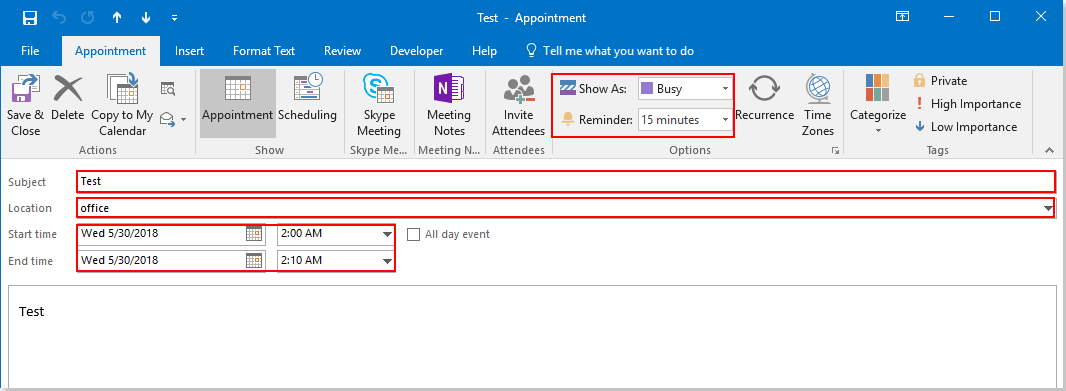Comment créer des rappels Outlook à partir d'une feuille de calcul Excel ?
Cet article explique comment créer des rappels Outlook basés sur les données d'une feuille de calcul Excel.
Créer des rappels Outlook à partir d'une feuille de calcul Excel avec du code VBA
Créer des rappels Outlook à partir d'une feuille de calcul Excel avec du code VBA
Si vous souhaitez créer des rappels Outlook à partir d'Excel, veuillez suivre les étapes ci-dessous.
1. Créez une feuille de calcul contenant les en-têtes de colonnes et les champs de rappel correspondants comme indiqué dans la capture d'écran ci-dessous.

Remarque : Pour la colonne "statut occupé", le chiffre "2" signifie que le rappel apparaîtra comme "Occupé" dans votre calendrier Outlook. Vous pouvez le modifier en "1 (Provisoire)", "3 (Hors du bureau)", "4 (Travail ailleurs)", ou "5 (Gratuit)" selon vos besoins.
2. Appuyez sur les touches "Alt" + "F11" pour ouvrir la fenêtre "Microsoft Visual Basic for Applications".
3. Dans la fenêtre "Microsoft Visual Basic for Applications", cliquez sur "Insérer" > "Module". Ensuite, copiez le code VBA suivant dans la fenêtre Code.
Code VBA : Créer des rappels Outlook à partir d'une feuille de calcul Excel
Sub AddAppointments()
'Update by Extendoffice 20180608
Dim I As Long
Dim xRg As Range
Dim xOutApp As Object
Dim xOutItem As Object
Set xOutApp = CreateObject("Outlook.Application")
Set xRg = Range("A2:G2")
For I = 1 To xRg.Rows.Count
Set xOutItem = xOutApp.CreateItem(1)
Debug.Print xRg.Cells(I, 1).Value
xOutItem.Subject = xRg.Cells(I, 1).Value
xOutItem.Location = xRg.Cells(I, 2).Value
xOutItem.Start = xRg.Cells(I, 3).Value
xOutItem.Duration = xRg.Cells(I, 4).Value
If Trim(xRg.Cells(I, 5).Value) = "" Then
xOutItem.BusyStatus = 2
Else
xOutItem.BusyStatus = xRg.Cells(I, 5).Value
End If
If xRg.Cells(I, 6).Value > 0 Then
xOutItem.ReminderSet = True
xOutItem.ReminderMinutesBeforeStart = xRg.Cells(I, 6).Value
Else
xOutItem.ReminderSet = False
End If
xOutItem.Body = xRg.Cells(I, 7).Value
xOutItem.Save
Set xOutItem = Nothing
Next
Set xOutApp = Nothing
End SubRemarque : Dans le code ci-dessus, "A2:G2" est la plage de données à partir de laquelle vous souhaitez créer des rendez-vous.
4. Appuyez sur "F5" ou cliquez sur le bouton "Exécuter" pour exécuter le code. Tous les rendez-vous avec des champs spécifiques seront alors insérés dans votre calendrier Outlook en une seule fois.
Vous pouvez ensuite accéder au Calendrier de votre Outlook pour afficher les résultats. Voir la capture d'écran :

Meilleurs outils de productivité pour Office
Dernière nouvelle : Kutools pour Outlook lance sa version gratuite !
Découvrez le tout nouveau Kutools pour Outlook avec plus de100 fonctionnalités incroyables ! Cliquez pour télécharger dès maintenant !
📧 Automatisation des E-mails : Réponse automatique (disponible pour POP et IMAP) / Programmer l’envoi d’un e-mail / CC/BCC automatique par règle lors de l’envoi / Transfert automatique (règle avancée) / Ajouter automatiquement une salutation / Diviser automatiquement les e-mails multi-destinataires en messages individuels ...
📨 Gestion des E-mails : Rappeler lemail / Bloquer les e-mails frauduleux par objet et autres critères / Supprimer les doublons / Recherche Avancée / Organiser les dossiers ...
📁 Pièces jointes Pro : Enregistrement en lot / Détachement en lot / Compression en lot / Enregistrer automatiquement / Détachement automatique / Compression automatique ...
🌟 Interface magique : 😊Plus d’emojis élégants et amusants / Vous rappelle lorsque des e-mails importants arrivent / Réduire Outlook au lieu de fermer ...
👍 Fonctions en un clic : Répondre à tous avec pièces jointes / E-mails anti-phishing / 🕘Afficher le fuseau horaire de l’expéditeur ...
👩🏼🤝👩🏻 Contacts & Calendrier : Ajouter en lot des contacts à partir des e-mails sélectionnés / Diviser un groupe de contacts en groupes individuels / Supprimer le rappel d’anniversaire ...
Utilisez Kutools dans votre langue préférée – prend en charge l’Anglais, l’Espagnol, l’Allemand, le Français, le Chinois et plus de40 autres !


🚀 Téléchargement en un clic — Obtenez tous les compléments Office
Recommandé vivement : Kutools pour Office (5-en-1)
Un clic pour télécharger cinq installateurs en une seule fois — Kutools pour Excel, Outlook, Word, PowerPoint et Office Tab Pro. Cliquez pour télécharger dès maintenant !
- ✅ Praticité en un clic : téléchargez les cinq packages d’installation en une seule action.
- 🚀 Prêt pour toutes les tâches Office : installez les compléments dont vous avez besoin, quand vous en avez besoin.
- 🧰 Inclus : Kutools pour Excel / Kutools pour Outlook / Kutools pour Word / Office Tab Pro / Kutools pour PowerPoint